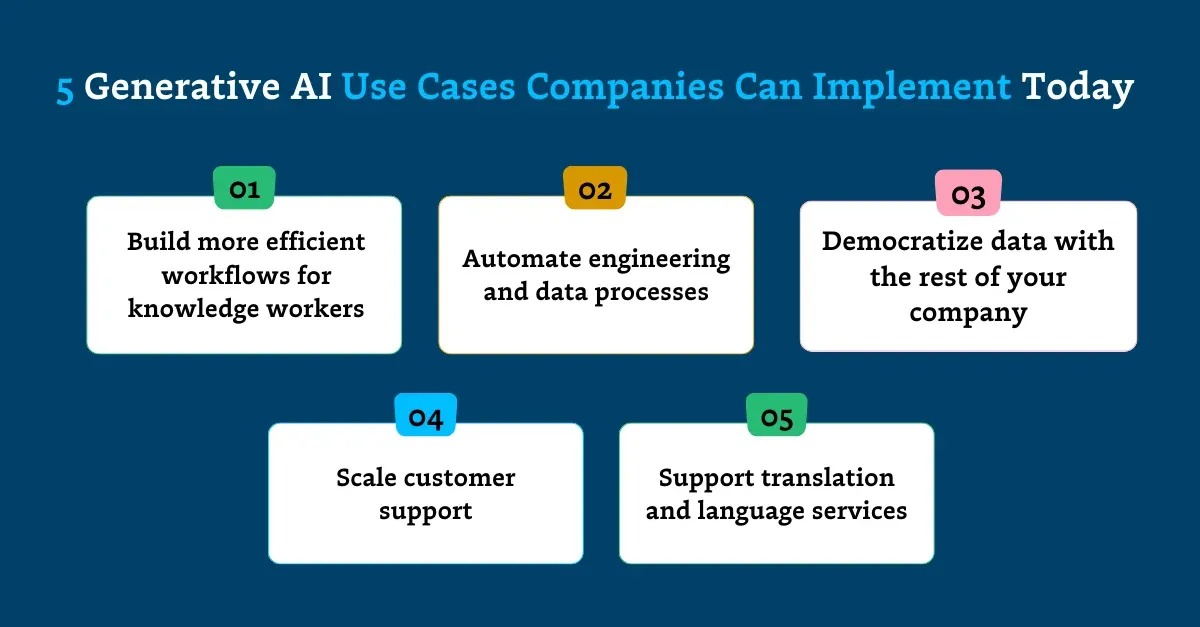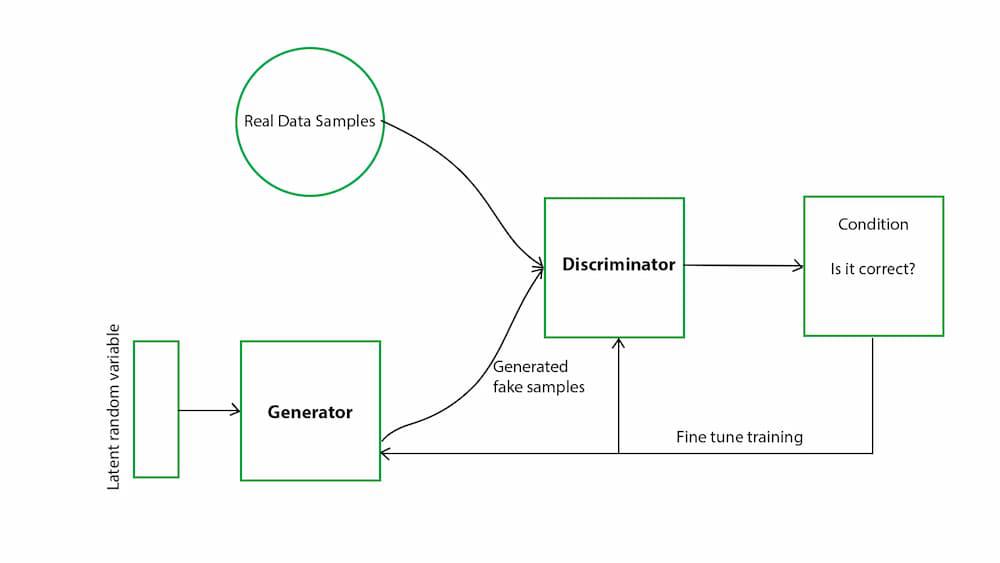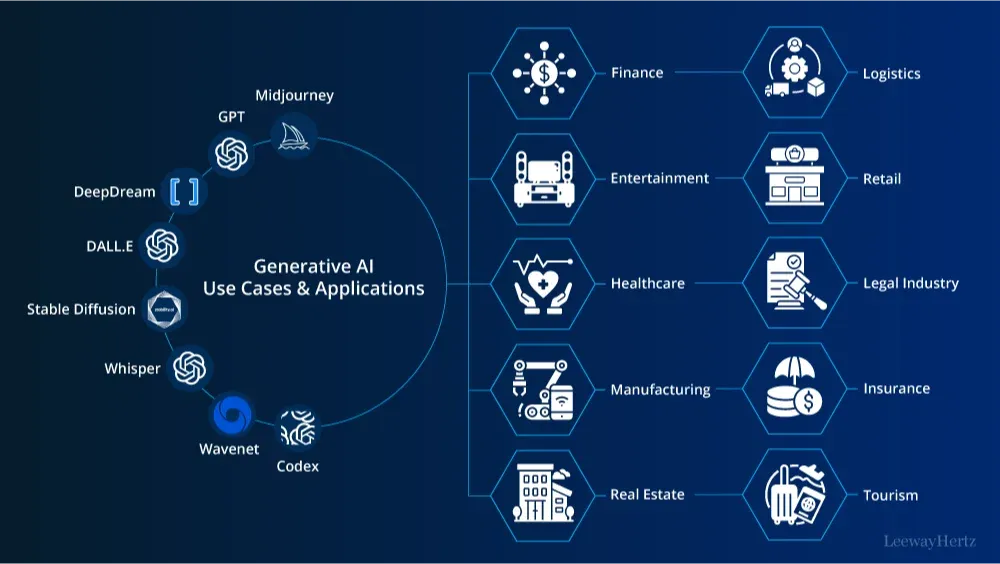Get ready to explore the thrilling world of generative AI! This cutting-edge technology is revolutionizing industries with its ability to create realistic images, videos, and even human-like conversations.
Imagine having a virtual assistant that can understand and respond to you like a real person, or a design tool that can generate infinite creative ideas with just a few clicks.
Generative AI is opening up a realm of possibilities once thought impossible. From personalized content that caters to your unique preferences to augmenting productivity in data analysis, this technology is transforming how we live and work.
But that's just the beginning. Brace yourself for mind-blowing breakthroughs, like high-resolution images that rival professional photography and video game content generated in real-time.
As we delve deeper into this blog, you'll uncover the latest trends, challenges, and ethical considerations surrounding generative AI development.
Get ready to have your perspective shifted and your imagination ignited. The future of AI is here, and it's more exciting than you ever imagined. Keep reading to explore the boundless potential of generative AI.
Use Cases of Generative AI Development

Generative artificial intelligence is opening new doors of possibilities across various industries.
Here are some of the diverse use cases of generative AI development:
Creating Realistic Images and Videos
Generative AI development tool can create realistic images and videos, which was considered impossible until recently.
Deep learning algorithms are trained using large datasets, teaching the neural network to generate images and videos similar to the real world.
This technology can help generate images for e-commerce websites, create immersive virtual environments, and generate photorealistic animations for movies and advertisements.
Enhancing Creativity in Art and Design
Generative AI development tool can enhance creativity in art and design by providing new tools and techniques for artists to express themselves.
Using generative AI, the designer can create complex patterns, textures, and designs that may not have been possible conventionally.
This technology can help artists generate new and fresh ideas, which break the monotony in traditionally static designs.
Personalized Content Generation
Generative AI development tool allows the personalization of content based on the user's preferences and actions.
Using generative models, it can generate personalized content for various applications, such as news articles, product recommendations, and social media content.
By providing the right content to the right person, it can increase user engagement tremendously.
Augmenting Productivity in Data Analysis
Generative AI development tool can augment productivity in data analysis by automating complex analytical tasks.
With the power of generative models, it can identify patterns and relationships in the data that humans might miss.
This technology can help predict market trends, identify fraud, and generate business insights that can be turned into actionable decisions.
Next, we will cover trends in generative AI development.
Emerging Trends in Generative AI Development
Generative AI development tool is a rapidly evolving field. Here are some of the emerging trends in generative AI development:
Deep Learning-Based Generative Models
Deep learning-based generative models use neural networks that mimic human thought processes, making them highly accurate and effective.
These models consume enormous amounts of data during the training process, generating more realistic and near-photorealistic outputs.
Transfer Learning and Fine-Tuning
Transfer learning and fine-tuning use pre-trained models to perform specific tasks by fine-tuning the pre-existing models that learned how to generalize and detect patterns in artificial intelligence problems.
It allows easier training and more accurate results.
Suggested Reading:
GANs (Generative Adversarial Networks) for Better Results

Generative Adversarial Networks is an advanced technique used to generate more realistic outputs.
It involves two neural networks – a generator network and a discriminator network – that work together in a game-like setting.
The generator network creates data examples that the discriminator network tries to identify as either real or fake. Over time, both networks improve, producing better and more realistic outputs.
Improved Natural Language Processing Capabilities

Natural Language Processing (NLP) is a field of computational linguistics that deals with the interaction between humans and machines using natural language.
Generative AI can generate natural sentences humans can understand, resulting in improved customer service, automated content creation, and chatbots.
Breakthroughs in Generative AI Development
Generative AI development tool has witnessed significant breakthroughs in recent years. Here are some of the notable advancements in the field:
Generating High-Resolution Images
One breakthrough in generative AI development is the ability to generate high-resolution images with impressive detail and realism.
Through the use of deep learning algorithms and neural networks, researchers have trained models capable of producing images that rival the quality of those captured by professional photographers.
This breakthrough opens up possibilities in various industries, including advertising, design, and virtual reality.

Generating Realistic Voice and Speech
Another breakthrough is the development of generative AI models that can generate realistic voice and speech.
By training on vast amounts of audio data, these models can mimic human speech patterns, accents, and emotions.
This advancement has applications in voice assistants, audiobook narration, and even in the entertainment industry for creating synthetic voices for characters.
Generating Video Game Content in Real-Time
Generative AI has also made breakthroughs in generating video game content in real-time.
Using procedural generation techniques, AI algorithms can create dynamic landscapes, characters, and objects with infinite variations.
This allows for more immersive and constantly evolving gaming experiences, reducing the need for manual content creation by game developers.
Generating Human-like Conversation
Advancements in natural language processing have led to breakthroughs in generating human-like conversation.
Generative AI models can now engage in dynamic and context-aware dialogue interactions, exhibiting characteristics such as humor, empathy, and knowledge.
These conversational agents have the potential to enhance customer service, create virtual companions, and assist with language learning.
For example, BotPenguin, A NO-CODE chatbot development platform allows users to integrate some of the prominent language models like GPT 4, Google PaLM and Anthropic Claude to create AI-powered chatbots for platforms like:
- WhatsApp Chatbot
- Facebook Chatbot
- WordPress Chatbot
- Telegram Chatbot
- Website Chatbot
- Squarespace Chatbot
- woocommerce Chatbot
- Instagram Chatbot
Challenges and Ethical Considerations
While generative AI development brings about exciting possibilities, there are also challenges and ethical considerations that need to be addressed:
Ethical Challenges Surrounding Generative AI Development
Ethical challenges arise when generative AI is used to generate content that can be deceptive or misleading.
For instance, creating deepfake videos, which can manipulate someone's appearance or speech, raises concerns about trust and the potential for misuse.
It is essential to establish guidelines and regulations to ensure the responsible and ethical use of generative AI technology.
Potential Biases and Discrimination Issues
Generative AI models are trained on large datasets, which may contain biases and reflect societal prejudices. This can lead to discriminatory outputs that perpetuate or amplify existing biases.
Efforts must be made to address and mitigate these biases to ensure fairness and equity in the outputs generated by generative AI systems.
Privacy and Security Concerns
Generative AI models require substantial amounts of data to train effectively. The collection and storage of this data raise concerns about privacy and security.
Safeguarding personal information and ensuring data protection should be a priority when deploying generative AI systems.
Next, we will cover prospects and the impact of generative AI development.
Suggested Reading:
Future Prospects and Impact of Generative AI Development
Generative AI development holds immense potential for the future, with far-reaching impacts across various industries and societal domains.
Potential Applications in Healthcare, Finance, and Other Industries
In healthcare, generative AI can revolutionize medical imaging, assisting doctors in diagnosing diseases more accurately and efficiently. It can also contribute to drug discovery and personalized medicine by generating synthetic molecules for potential therapeutic purposes.
In the financial industry, generative AI can be utilized for risk assessment, fraud detection, and custom financial advice based on individual preferences and goals.
Moreover, generative AI has applications in creative fields such as art, music, and fashion, where it can assist artists and designers in generating unique and innovative works.
Influence on Job Automation and Workforce Transformation
As generative AI evolves, there is a possibility of job automation and transformation in various sectors.
Repetitive and mundane tasks, such as data entry and content creation, can be automated using generative AI, allowing human workers to focus on more complex and creative aspects of their jobs.
This can lead to increased productivity and efficiency in industries while reshaping the job market and requiring new skill sets to adapt to the changing workforce landscape.
Societal Implications and the Need for Responsible AI Development
The impact of generative AI raises important societal implications that must be addressed.
The responsible development of generative AI technology is crucial to preventing misuse and harm.
Ethical considerations, such as privacy, fairness, and transparency, must be at the forefront of AI development.
Regulations and guidelines should be established to ensure that generative AI is used ethically and for the benefit of society.
Ongoing research and collaboration between AI developers, policymakers, and experts in various fields are essential to creating a framework that fosters responsible AI development.
Conclusion
Generative AI is undoubtedly revolutionizing the world as we know it.
From groundbreaking advancements in healthcare to transforming creative industries, its impact is far-reaching.
However, it's crucial to navigate this technological frontier responsibly, addressing ethical concerns and mitigating biases.
Embracing generative AI with a thoughtful approach will pave the way for a future where humans and machines collaborate harmoniously.
Unlock the power of generative AI with BotPenguin's cutting-edge chatbot service.
Our advanced language models engage in natural, context-aware conversations, offering personalized assistance tailored to your needs.
Whether you're seeking customer support, virtual companionship, or language learning, BotPenguin's conversational AI is here to enhance your experience.
Embrace the future of seamless human-machine interaction today.
Suggested Reading:
Frequently Asked Questions (FAQs)
What are the key applications of generative AI across different industries?
Generative AI finds applications in diverse fields, including healthcare, finance, and creative arts. Its potential spans from medical image synthesis to financial market predictions and creative content generation.
How is generative AI contributing to advancements in healthcare and medical research?
Generative AI contributes to healthcare through tasks like disease detection in medical imaging and drug discovery, accelerating advancements in medical research and diagnosis.
How does generative AI foster innovation in the design and architecture industries?
Generative AI contributes to design and architecture by generating optimized layouts, creating unique patterns, and supporting sustainable design practices, fostering innovation in these industries.
Can generative AI models be fine-tuned for specific tasks or industries?
Absolutely. Generative AI models can be fine-tuned for specific tasks through transfer learning, enabling their adaptation to new datasets or industries for enhanced performance.

